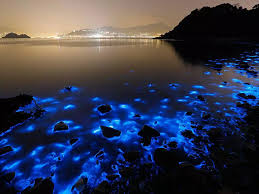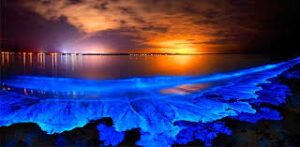Argentinian beaches are not only known for their natural beauty and summer environment, but also for an impressive phenomenon that, at times, illuminates the sea with bluish and greenish tones: marine bioluminescence, better known as fluorescent waves.
Marine bioluminescence is a phenomenon in which the water glows due to the presence of microorganisms, mainly dinoflagellates. When the waves or human movement agitate them, they release a substance that, upon reacting with oxygen, naturally produces light. This chemical reaction involves luciferin, a compound that oxidizes with the help of an enzyme called luciferase, generating the characteristic fluorescent glow.
Although there are no exact dates, this phenomenon is more common during the summer months, between January and March, when the water temperature is warmer and favors phytoplankton proliferation. Factors such as calm waters, low light pollution, and little wind increase the chances of the glow being more intense and visible.

Where Have Fluorescent Waves Been Seen?
Over the years, marine bioluminescence has been observed on various beaches along the Argentine Atlantic coast, including:
- Mar del Plata
- Pinamar
- Villa Gesell
- Cariló
Visitors have been able to capture striking images of the glowing waves at night, creating a dreamlike seascape.
When Does Bioluminescence Occur?
Bioluminescence is a process that occurs in some living organisms, in which the energy generated by a chemical reaction manifests as light. Most of the time it can be seen at night on beaches, at the shore and where the waves break. That is the moment when daylight does not hinder visibility.
Its name comes from the combination of two words derived from Latin: “Bios”, meaning living, and “Lumen”, meaning light. It is a widespread phenomenon at all biological levels, but it is mainly present in deep-sea species. In fact, it is estimated that 90% of deep-sea organisms exhibit bioluminescence.

Tips for Witnessing the Natural Spectacle
For those wishing to experience this unique phenomenon, it is recommended to:
- Visit the beach at night.
- Choose days with little artificial light and without a full moon
- Opt for areas with less human activity and moderate waves
Marine bioluminescence is a completely safe phenomenon. The microorganisms responsible for this phenomenon are not toxic or harmful to human health, so the spectacle can be enjoyed without worries.
Have you visited our YouTube channel yet? Subscribe now!

